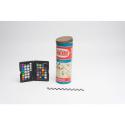Currently indexing
Constuction set
Classification(s):
Wood
Date: 1964
Organisation: The Toy Tinkers division of A.G Spalding & Bros. Incl.
Organisation: Allen Wood Products
Dimensions:
256 × 91 mm (25.6 × 9.1 cm)
Medium: Wood
Object number: W456E
Place of Production:Canada
Title:Tinkertoy
Description‘The Original Tinkertoy’ construction set, with storage tube and a ‘Direction and Idea Book’. Made in 1964 by The Toy Tinkers division of A.G. Spalding & Bros. Incl., and manufactured by Allen Wood Products Ltd., in Canada. The complete ‘Tinkertoy’ set has 98 hardwood and plastic parts. This set is incomplete, it includes rods of various sizes and colours (in size order from largest to smallest: 6 green, 8 red, 6 blue, 5 yellow, 2 orange – one of which is inserted into an ‘L’ joint piece. There are 5 spools, 4 wheels, 1 ‘W’ joint piece, 4 ‘L’ joint pieces (one of which has an orange rod inserted into it), a single ‘ZP’ joint piece and a single ‘B’ rod with pointed tip. The following joint pieces are missing: U, BG Large hole, TP and CP. There are 3 sets of wind-blades; one set has one wind blade missing. There are 3 additional wooden pieces not inventoried on the instructional leaflet.
ProvenanceThis object was originally acquired for the Inner London Education Authority’s (ILEA) ‘Circulating Design Scheme’ collection.
The collection was instigated by the London Country Council (later the Greater London Council) and the Council of Industrial Design (COID). The collection’s original purpose was concerned with the teaching and dissemination of modern, ‘good design’.
The collection was established in 1951/52 as the ‘Experiment in Design Appreciation’, later renamed the ‘Circulating Design Scheme’.
The Circulating Design Scheme lent boxed showcases to London schools. The showcases contained handling objects, material samples and interpretation on a specific subject.
COID withdrew its involvement in the Scheme in 1957. After which time, it was managed exclusively by the London County Council from 1957-1963.
After the administrative restructuring of London authorities, the Scheme was jointly managed by the Greater London Council and the Inner London Education Authority (ILEA) from 1963 – 1976.
The Scheme was operational until 1976 when the collections were withdrawn from circulation. ILEA was abolished in the late 1980s and the collection was donated to Camberwell College of Arts in 1989/90.
ILEA was responsible for secondary and tertiary education in the inner London boroughs, this included Camberwell.
The collection was instigated by the London Country Council (later the Greater London Council) and the Council of Industrial Design (COID). The collection’s original purpose was concerned with the teaching and dissemination of modern, ‘good design’.
The collection was established in 1951/52 as the ‘Experiment in Design Appreciation’, later renamed the ‘Circulating Design Scheme’.
The Circulating Design Scheme lent boxed showcases to London schools. The showcases contained handling objects, material samples and interpretation on a specific subject.
COID withdrew its involvement in the Scheme in 1957. After which time, it was managed exclusively by the London County Council from 1957-1963.
After the administrative restructuring of London authorities, the Scheme was jointly managed by the Greater London Council and the Inner London Education Authority (ILEA) from 1963 – 1976.
The Scheme was operational until 1976 when the collections were withdrawn from circulation. ILEA was abolished in the late 1980s and the collection was donated to Camberwell College of Arts in 1989/90.
ILEA was responsible for secondary and tertiary education in the inner London boroughs, this included Camberwell.
NotesThis object was circulated to London schools as part of the Inner London Education Authority’s (I.L.E.A) Circulating Design Scheme, which operated from 1951-1976. The Tinkertoy construction set featured in the ‘Design for Play Children’s Toys’ group in case number 2. The boxed showcase explores children’s toys for children aged 5 and over, suggesting this age group play “complicated games and are able to use their minds and hands to make many things”. The showcase encourages the viewer to ask the following questions when considering the suitability of a toy. Is it suitable for the age? Is it safe? Will it last? The original supplier from whom this object was acquired is unknown. The associated record card indicates the boxed showcase was in use from 1970-76. Original photograph of boxed showcase by an unknown photographer.






